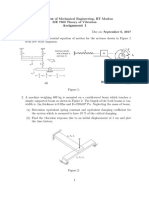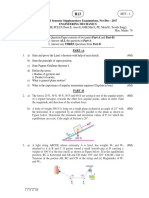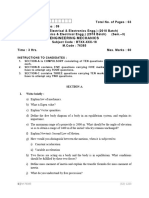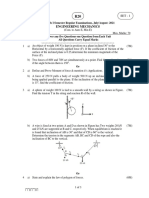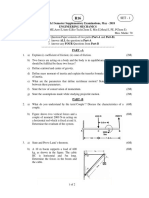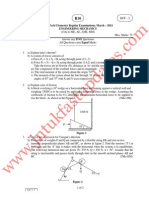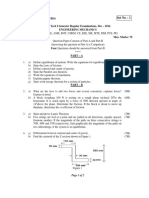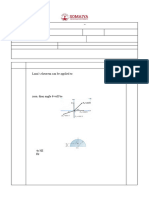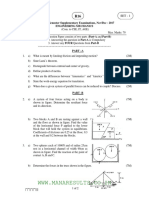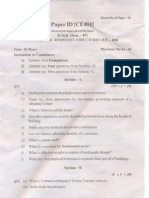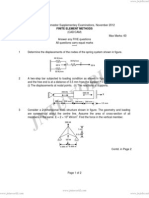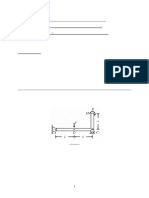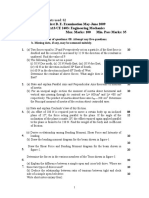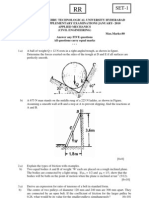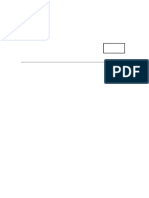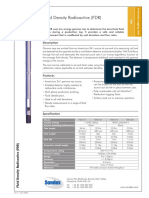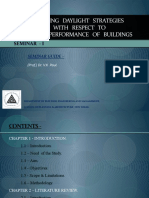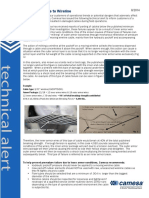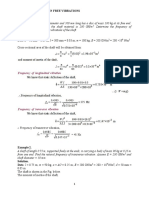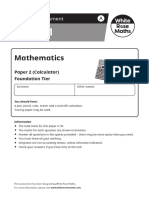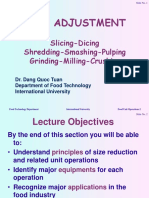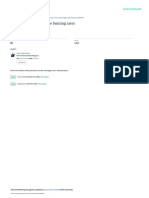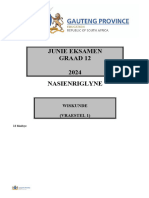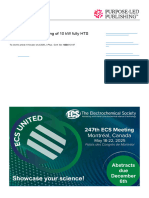Engineering Mechanics Dec 2013
Engineering Mechanics Dec 2013
Uploaded by
api-248483124Copyright:
Available Formats
Engineering Mechanics Dec 2013
Engineering Mechanics Dec 2013
Uploaded by
api-248483124Original Title
Copyright
Available Formats
Share this document
Did you find this document useful?
Is this content inappropriate?
Copyright:
Available Formats
Engineering Mechanics Dec 2013
Engineering Mechanics Dec 2013
Uploaded by
api-248483124Copyright:
Available Formats
J
N
T
U
W
O
R
L
D
Code No: R21031
II B. Tech I Semester Supplementary Examinations Dec 2013
ENGINEERING MECHANICS
(Com to ME, AE, AME, MM)
Time: 3 hours Max. Marks: 75
Answer any FIVE Questions
All Questions carry Equal Marks
~~~~~~~~~~~~~~~~~~~~~~~~~
1. a) How do you resolve a force into a force couple system about another point? Explain.
b) The parallel force system of five forces of magnitudes 12 kN, 15 kN, 24 kN, 30 kN,
and 20 kN is shown in the Figure1. Reduce them to a force and couple at the point P.
(6M+9M)
2. a) Explain the equilibrium of i) Concurrent force system, and ii) General force system.
b) Determine the reactions at all the supports of the beam / structure shown in Figure 2.
(6M+9M)
3. a) What is centroid? Derive an expression for the centroid of a sector of a circle.
b) Find the centroid of the shaded plane area shown in the Figure 3. (7M+8M)
1 of 3
R10
SET - 1
www.jntuworld.com || www.android.jntuworld.com || www.jwjobs.net || www.android.jwjobs.net
www.jntuworld.com || www.jwjobs.net
J
N
T
U
W
O
R
L
D
Code No: R21031
4. a) State and prove the Parallel axis theorem to find the M.I. of a plane area w.r.t. any
reference axis in its plane.
b) The shaded area shown in the Figure 4 is 125 cm
2
. If I
xx
= 35,000 cm
4
, I
x'x'
= 70,000
cm
4
, and d
2
= 7.5 cm, determine the distance d
1
and the M.I. of the area w.r.t. the
centroidal axis parallel to the axis x x. (5M+10M)
5. a) Explain the procedure to determine the forces in the members of a perfect frame by
the method of joints.
b) Determine the forces induced in the members of the pin jointed truss shown in the
Figure 5. Show the values on a neat diagram of the truss, and mention clearly the
nature of the force (tension or compression) in each member. (6M+9M)
6. a) Derive the expressions for the magnitude and direction of the rectangular component
of acceleration of a particle moving along a curved path.
b) The motion of a particle in rectilinear motion is defined by the relation :
s = 2t
3
9t
2
+ 12t 10, where s is expressed in meters and t in seconds. Determine:
i) The acceleration of the particle when the velocity is zero.
ii) The position and total distance travelled by the particle when the acceleration is
zero. (6M+9M)
2 of 3
R10
SET - 1
www.jntuworld.com || www.android.jntuworld.com || www.jwjobs.net || www.android.jwjobs.net
www.jntuworld.com || www.jwjobs.net
J
N
T
U
W
O
R
L
D
Code No: R21031
7. a) State and prove the Work Energy principle.
b) A 200 N block is originally at rest on a horizontal surface, for which the coefficient
static friction is 0.6 and the coefficient of kinetic friction is 0.5. If a horizontal force
is applied such that it varies with time as shown in the Figure 6, determine the
speed of the block in 10 seconds. (6M+9M)
8. a) State the Coulombs laws of friction. Also explain the terms Dry friction and Cone
of friction.
b) The mean diameter of threads of a square threaded screw is 50 mm. The pitch of
the thread is 6 mm. The coefficient of friction is 0.15. What force must be applied
at the end of a 600 mm lever, which is perpendicular to the longitudinal axis of the
screw to raise a load of 17.5 kN, and to lower the same load? (6M+9M)
3 of 3
R10
SET - 1
F
F(N)
t (s)
200
5 10 o
Figure 6
www.jntuworld.com || www.android.jntuworld.com || www.jwjobs.net || www.android.jwjobs.net
www.jntuworld.com || www.jwjobs.net
J
N
T
U
W
O
R
L
D
Code No: R21031
II B. Tech I Semester Supplementary Examinations Dec 2013
ENGINEERING MECHANICS
(Com to ME, AE, AME, MM)
Time: 3 hours Max. Marks: 75
Answer any FIVE Questions
All Questions carry Equal Marks
~~~~~~~~~~~~~~~~~~~~~~~~~
1. a) State and prove (i) Varignons theorem, and (ii) Law of Parallelogram of forces.
b) The four forces shown in the Figure 1 are to be replaced by one force and moment
about A. Find the magnitudes of this force and moment. (6M+9M)
2. a) Explain the equilibrium of i) Collinear force system, and ii) Parallel force system.
b) Determine the reactions at all the supports of the beam / structure shown in Figure 2.
(6M+9M)
1 of 3
R10
SET - 2
www.jntuworld.com || www.android.jntuworld.com || www.jwjobs.net || www.android.jwjobs.net
www.jntuworld.com || www.jwjobs.net
J
N
T
U
W
O
R
L
D
Code No: R21031
3. a) State and prove the first and second Pappus Guldinus theorems.
b) A composite solid built by a cone, cylinder, and hemisphere is shown in the
Figure 3. Locate the centroid w.r.t. the origin. (8M+7M)
4. a) Describe the procedure to find the mass moment of inertia of a thin circular ring.
b) ABC is an isosceles triangle of base 100 mm and height 90 mm. A square of side
a , with its geometric center at a distance of 30 mm from the base of the triangle ,
is removed from the triangular lamina. If the M.I of the net figure is 80 % of that
of the original triangle, find the size of the square. (6M+9M)
5. a) In a cantilever truss, support reactions are not required for the analysis of truss
Justify and explain this statement with a suitable example.
b) Find the force in the member AD of the plane truss shown in Figure 4. by the
method of sections. (6M+9M)
2 of 3
R10
SET - 2
www.jntuworld.com || www.android.jntuworld.com || www.jwjobs.net || www.android.jwjobs.net
www.jntuworld.com || www.jwjobs.net
J
N
T
U
W
O
R
L
D
Code No: R21031
6. a) Draw the acceleration time (a t) curve for rectilinear motion of a particle. How
do you find the displacement and the change in velocity of the particle from the
a t curve?
b) In curvilinear motion, a particle P moves along the fixed path given by 9y = x
2
,
where x and y are expressed in cm. At any instant t, the x coordinate of P is
given by x = t
2
14 t. Determine the y component of the velocity and acceleration
of P when t = 15 seconds. (6M+9M)
7. a) Distinguish between centroidal rotation and non centroidal rotation of a rigid body
about a fixed axis.
b) A spring mass system has a mass m attached to a spring from the ceiling. When
the mass hangs freely, it stretches the spring by a distance C. Show that, if the mass
is suddenly released, the spring stretches a distance of 2C before the mass starts to
return upward. (6M+9M)
8. a) Distinguish between static friction, limiting friction, and kinetic friction.
b) Two rectangular blocks of weights W
1
= 150 N, and W
2
= 100 N are connected by a
string, and rest on a horizontal surface and on an inclined plane, as shown in
Figure 4. The coefficient of friction for all the contiguous surfaces is 0.2. Find the
magnitude and direction of the least force P at which the motion of the blocks will
impend.
3 of 3
R10
SET - 2
www.jntuworld.com || www.android.jntuworld.com || www.jwjobs.net || www.android.jwjobs.net
www.jntuworld.com || www.jwjobs.net
J
N
T
U
W
O
R
L
D
Code No: R21031
II B. Tech I Semester Supplementary Examinations Dec 2013
ENGINEERING MECHANICS
(Com to ME, AE, AME, MM)
Time: 3 hours Max. Marks: 75
Answer any FIVE Questions
All Questions carry Equal Marks
~~~~~~~~~~~~~~~~~~~~~~~~~
1. a) Explain the procedure to find the resultant of :
i) Concurrent force system ii) Parallel force system
b) The resultant of four vertical forces is a couple of 300 N-m about the centre 0.
Three of these forces are shown in the Figure 1. Determine the fourth force. (8M+7M)
2. a) State and prove Lamis theorem. What are its limitations?
b) Determine the reactions at all the supports of the beam / structure shown in Figure 2.
(6M+9M)
3. a) Describe the procedure to locate the centroid of a composite area.
b) Show that the coordinates of the centroid G of the area between a parabola
2
x
y
a
=
and a straight line y = x (as shown in Figure) are given by : x =
2
a
, y =
2
5
a
.
(5M+10M)
1 of 2
R10
SET - 3
www.jntuworld.com || www.android.jntuworld.com || www.jwjobs.net || www.android.jwjobs.net
www.jntuworld.com || www.jwjobs.net
J
N
T
U
W
O
R
L
D
Code No: R21031
4. a) How do you find the M.I. of a triangle about the centroidal axis parallel to the
base? Describe the procedure, assuming the base equal to a and height equal to h.
b) Determine the M.I. of the shaded area shown in the Figure 3 about the centroidal x
axis and the centroidal y axis. All dimensions in the figure are in cm. (8M+7M)
5. a) What is a perfect truss? Sketch at least four examples of perfect trusses, and show
that they satisfy the relationship between the number of members, number of joints,
and the number of support reaction components.
b) For the truss loaded as shown in Figure 4, find the forces in the members CE and
CF by the method of sections. (8M+7M)
6. a) Explain the curvilinear motion by the tangential and normal component method.
b) Two trains P and Q start from the same station on parallel lines. The train P starts
from rest with y uniform acceleration of 0.2 m / s
2
, and attains a speed of 10 m / s.
Further the speed is kept constant. The train Q leaves 30 seconds later with uniform
acceleration of 0.5 m / s
2
from rest, and attains a maximum speed of 20 m / s. When
will the train Q overtake P ? (6M+9M)
7. a) State and derive the Impulse Momentum principle.
b) The armature of an electric motor comes to rest in x seconds after the power is cut
off. If the armature speed was n rpm before the power was cut off, what is its
angular deceleration, assuming it to be uniform? What are the number of revolutions
made by the armature before stopping? (6M+9M)
8. a) Derive the expression for screw friction.
b) A person of weight W is ascending a 5 m ladder which is held against a smooth
wall at an inclination of 40
0
with the horizontal ground. If the coefficient of friction
between the ladder and ground is 0.3, how far up the ladder may the person climb
before the sliding motion of the ladder takes place? (6M+9M)
2 of 2
R10
SET - 3
www.jntuworld.com || www.android.jntuworld.com || www.jwjobs.net || www.android.jwjobs.net
www.jntuworld.com || www.jwjobs.net
J
N
T
U
W
O
R
L
D
Code No: R21031
II B. Tech I Semester Supplementary Examinations Dec 2013
ENGINEERING MECHANICS
(Com to ME, AE, AME, MM)
Time: 3 hours Max. Marks: 75
Answer any FIVE Questions
All Questions carry Equal Marks
~~~~~~~~~~~~~~~~~~~~~~~~~
1. a) Explain the composition of forces by the method of resolution.
b) Determine the resultant force and moment acting on a body, whose centroid is (2,2,2)
Due to the following forces / moments. (6M+9M)
M
1
= (12 i + 10 j + 8 k) kN-m at A (0,2,0)
M
2
= (4 i + 10 j - 8 k) kN-m at B (2,1,2)
M
3
= ( i + 2 j + 3 k) kN-m at D (2,4,3)
F
1
= (4 i + 5 j - 6 k) kN-m at C (4,3,4)
F
2
= (5 j - 5 k) kN-m at B (2,5,7)
2. a) Explain the types of supports, and indicate the unknown reactions they offer.
b) Determine the reactions at all the supports of the beam / structure shown in Figure 1.
(6M+9M)
3. Prove that the centroid of the shaded area shown in the Fig.2 w.r.t. the x and y axes
is given by : x =
3
2
sin
3
sin 2
2
r
. (15M)
1 of 3
R10
SET - 4
www.jntuworld.com || www.android.jntuworld.com || www.jwjobs.net || www.android.jwjobs.net
www.jntuworld.com || www.jwjobs.net
J
N
T
U
W
O
R
L
D
Code No: R21031
4. a) State and prove the Perpendicular axis theorem to find the M.I. of a plane area.
b) Find the M.I. of a section shown in the Fig3 about the :
i) x axis ; ii) y axis ; iii) Parallel centroidal x axis ; and iv) Parallel
centroidal y axis. (4M+11M)
5. a) State the assumptions for a perfect truss.
b) A simple plane truss is shown in Figure 4. Two 1,000 N loads are acting on the pins
at C and E. Determine the forces in all the members , using the method of joints.
(5M+10M)
6. a) Derive the relation for the component of normal acceleration of a particle moving
along a curved path.
b) A particle under a constant deceleration is moving in a straight line, and covers a
distance of 20 m in the first two seconds and 40 m in the next 5 seconds. Calculate
the distance it covers in the subsequent 3 seconds, and the total distance covered
before it comes to rest. (6M+9M)
7. a) Explain the following terms :
i) Impulse, ii) Impact, iii) Momentum, iv) Coefficient of restitution.
b) A 50 gm golf ball is hit at an angle of 40
0
with the horizontal. The ball leaves the
Tee, and lands at the same elevation 15 m away. Determine the impulse on the ball.
(8M+7M)
2 of 3
R10
SET - 4
www.jntuworld.com || www.android.jntuworld.com || www.jwjobs.net || www.android.jwjobs.net
www.jntuworld.com || www.jwjobs.net
J
N
T
U
W
O
R
L
D
Code No: R21031
8. a) What is a wedge, and where is it used? Why is the coefficient of static friction
greater than the coefficient of kinetic friction?
b) In the Figure 5 shown below, the wedge is used to level the member. For the loading
shown, determine the horizontal force P that must be applied to move the wedge to
the right. The coefficient of static friction between the wedge and its surfaces of
contact may be taken as 0.25. (6M+9M)
3 of 3
R10
SET - 4
www.jntuworld.com || www.android.jntuworld.com || www.jwjobs.net || www.android.jwjobs.net
www.jntuworld.com || www.jwjobs.net
You might also like
- Ge 131 - Engineering Mechanics Question BankDocument3 pagesGe 131 - Engineering Mechanics Question BankAnonymous RJfsy8PtNo ratings yet
- ME7360 Assignment 1 PDFDocument3 pagesME7360 Assignment 1 PDFVivek V ShetNo ratings yet
- Plastic Hinge Length of Reinforced Concrete ColumnsDocument11 pagesPlastic Hinge Length of Reinforced Concrete ColumnsSiavash BayeganNo ratings yet
- 7W 11bt11202022 PDFDocument22 pages7W 11bt11202022 PDFNagarjuna KonduruNo ratings yet
- Mechanics Question - Paper JntukDocument3 pagesMechanics Question - Paper JntukVinay KumarNo ratings yet
- Engineering Mechanics: Instructions To CandidatesDocument3 pagesEngineering Mechanics: Instructions To Candidatesdamansahota2902No ratings yet
- WWW - Manaresults.co - In: I B. Tech II Semester Regular/Supplementary Examinations, April/May - 2019 Engineering MechanicsDocument10 pagesWWW - Manaresults.co - In: I B. Tech II Semester Regular/Supplementary Examinations, April/May - 2019 Engineering MechanicsJohny SkNo ratings yet
- WWW - Manaresults.Co - In: I B. Tech I Semester Regular/Supplementary Examinations, Oct/Nov - 2018 Engineering MechanicsDocument12 pagesWWW - Manaresults.Co - In: I B. Tech I Semester Regular/Supplementary Examinations, Oct/Nov - 2018 Engineering MechanicsArivaNo ratings yet
- WWW - Manaresults.co - In: Engineering MechanicsDocument3 pagesWWW - Manaresults.co - In: Engineering MechanicssheikthurabbNo ratings yet
- STRL Dynamics M. TechDocument4 pagesSTRL Dynamics M. TechNandeesh SreenivasappaNo ratings yet
- Engineering Mechanics July 2021Document3 pagesEngineering Mechanics July 2021DANDEM SAIRAMNo ratings yet
- WWW - Manaresults.Co - In: I B. Tech I Semester Supplementary Examinations, May - 2018 Engineering MechanicsDocument2 pagesWWW - Manaresults.Co - In: I B. Tech I Semester Supplementary Examinations, May - 2018 Engineering MechanicssheikthurabbNo ratings yet
- Engineering Mechanics1Document8 pagesEngineering Mechanics1Srikrishna JanaNo ratings yet
- Jntuk 1-1 R16 Q.P Dec 2016 - ENGINEERING MECHANICSDocument10 pagesJntuk 1-1 R16 Q.P Dec 2016 - ENGINEERING MECHANICScoolmanbalu2004No ratings yet
- Engineering Mechanics - 116U06C104Document5 pagesEngineering Mechanics - 116U06C104twisha.dwivediNo ratings yet
- WWW - Manaresults.Co - In: I B. Tech I Semester Regular/Supplementary Examinations, Nov/Dec - 2017 Engineering MechanicsDocument16 pagesWWW - Manaresults.Co - In: I B. Tech I Semester Regular/Supplementary Examinations, Nov/Dec - 2017 Engineering Mechanicsravi maskeNo ratings yet
- Engineering Mechanics AME1103Document4 pagesEngineering Mechanics AME1103Ravi Kiran GotetiNo ratings yet
- R 161216112017Document3 pagesR 161216112017srinivasallam1986_87No ratings yet
- Engineering Mechanics March 2014r13Document14 pagesEngineering Mechanics March 2014r13api-248483124No ratings yet
- In Transiation.: Starting From Est (1Document3 pagesIn Transiation.: Starting From Est (1shivanagamitra019No ratings yet
- TSM101 (SS2019) - Set ADocument9 pagesTSM101 (SS2019) - Set ANgeedup DhojeeNo ratings yet
- ADocument10 pagesANaman Poswal Class 9DNo ratings yet
- Mechanics of Deformable BodiesDocument21 pagesMechanics of Deformable BodiesVarun. hrNo ratings yet
- Computational Structural EngineeringDocument26 pagesComputational Structural EngineeringVarun. hrNo ratings yet
- Em MAY JUNE 2010Document0 pagesEm MAY JUNE 2010Bala SubramanianNo ratings yet
- Finite Element MethodsDocument12 pagesFinite Element Methodspraneeth4a100% (1)
- QP Firstyear Supply Nov09 Classical Mechanics PDFDocument14 pagesQP Firstyear Supply Nov09 Classical Mechanics PDFkalirajgurusamyNo ratings yet
- Paper ID (CE404) : Roll No. ...................... Total No. of Questions: 09)Document2 pagesPaper ID (CE404) : Roll No. ...................... Total No. of Questions: 09)anuj sethNo ratings yet
- Engineering Mechanics Question Papers MAY - June 2009Document6 pagesEngineering Mechanics Question Papers MAY - June 2009J R Vinod KumaarNo ratings yet
- Second Semester Examination, 2002-2003: B. TechDocument7 pagesSecond Semester Examination, 2002-2003: B. Techlatendra kumar srivastavNo ratings yet
- 152AH052019Document4 pages152AH052019చిమ్ముల సందీప్ రెడ్డిNo ratings yet
- Sa 1Document3 pagesSa 1Rama BhandareNo ratings yet
- April 2011 2008Document7 pagesApril 2011 2008Piyush BhandariNo ratings yet
- Mechanics: Graph Paper Is Available in The Examination RoomDocument6 pagesMechanics: Graph Paper Is Available in The Examination RoomIoana BoilaNo ratings yet
- 9D04102 Finite Element MethodsDocument2 pages9D04102 Finite Element Methodsjbsng123No ratings yet
- Engineering Mechanic Sem 1 Session 1011 (Nov)Document10 pagesEngineering Mechanic Sem 1 Session 1011 (Nov)Amirul AizatNo ratings yet
- PPP0101 Principles of Physics Tutorial 1Document4 pagesPPP0101 Principles of Physics Tutorial 1TAN XIN YINo ratings yet
- MA3002 2022-2023 Semester 1Document5 pagesMA3002 2022-2023 Semester 1kong99942No ratings yet
- Kings: Engineering MechanicsDocument16 pagesKings: Engineering Mechanicsgovind4ever5No ratings yet
- First B. E. Examination May-June 2009 2x13/CE 2403: Engineering Mechanics Time: Three Hours Max. Marks: 100 Min. Pass Marks: 35Document2 pagesFirst B. E. Examination May-June 2009 2x13/CE 2403: Engineering Mechanics Time: Three Hours Max. Marks: 100 Min. Pass Marks: 35Sanjay TiwariNo ratings yet
- QUESTIONDocument15 pagesQUESTIONHammad SargurohNo ratings yet
- Jntu Anan I Year Enggmecha Set 2Document9 pagesJntu Anan I Year Enggmecha Set 2prasaad08No ratings yet
- Engineering MechanicsDocument18 pagesEngineering MechanicsSiva ChidambaramNo ratings yet
- 14CV1ICENM2018Document4 pages14CV1ICENM2018boomtikkitikkiboomNo ratings yet
- Mechanics of MaterialsDocument0 pagesMechanics of Materialssatishkumarkolluru9809No ratings yet
- Docs Me Fem Assignments 2013Document8 pagesDocs Me Fem Assignments 2013Sanju ReddyNo ratings yet
- Rr10302 Applied MechanicsDocument12 pagesRr10302 Applied MechanicsSRINIVASA RAO GANTANo ratings yet
- Engineering Mechanics Question Full 4Document2 pagesEngineering Mechanics Question Full 4Samir BoseNo ratings yet
- Namma Kalvi 11th Physics Volume 1 Model Question Paper EM 221346Document4 pagesNamma Kalvi 11th Physics Volume 1 Model Question Paper EM 221346ganbuphysics80No ratings yet
- 14CV1ICENM2016Document3 pages14CV1ICENM2016boomtikkitikkiboomNo ratings yet
- Mock Test 01 EM 2024-25Document5 pagesMock Test 01 EM 2024-2516swapnilmauryaNo ratings yet
- B.Tech Question Papers 4Document5 pagesB.Tech Question Papers 4akrgcetNo ratings yet
- Engineering Mechanics IDocument5 pagesEngineering Mechanics IBhanu prakashNo ratings yet
- 22203-Applied-Mechanics-sample-question-paperDocument7 pages22203-Applied-Mechanics-sample-question-paperpramodpisal598No ratings yet
- 09-Finite Element Analysis March 2010Document2 pages09-Finite Element Analysis March 2010simalaraviNo ratings yet
- Mtech. Finite Element AnalysisDocument11 pagesMtech. Finite Element Analysissimalaravi100% (2)
- O level Physics Questions And Answer Practice Papers 2From EverandO level Physics Questions And Answer Practice Papers 2Rating: 5 out of 5 stars5/5 (1)
- Chem LabDocument16 pagesChem LabNickstar592No ratings yet
- Water Tank Seismic FORCES - SEFPDocument15 pagesWater Tank Seismic FORCES - SEFPHur HasanNo ratings yet
- Time Table - Summer Supplementary 2022Document16 pagesTime Table - Summer Supplementary 2022Dayanand pawarNo ratings yet
- Fluid Density Radioactive (FDR) : DescriptionDocument1 pageFluid Density Radioactive (FDR) : DescriptionKarim IsmailNo ratings yet
- Optimizing Daylight Strategies With Respect To Thermal Performance of BuildingsDocument84 pagesOptimizing Daylight Strategies With Respect To Thermal Performance of BuildingsAbhijit RastogiNo ratings yet
- Packoff Damage To WirelineDocument1 pagePackoff Damage To WirelineArmanNo ratings yet
- Pertemuan Ke 1 MKEDocument6 pagesPertemuan Ke 1 MKEpietrasamudraNo ratings yet
- Worked ExamplesDocument5 pagesWorked Exampleskebba kahNo ratings yet
- Year 11 Paper 2 Foundation Autumn (A) 2021Document16 pagesYear 11 Paper 2 Foundation Autumn (A) 2021zaara.kauserxNo ratings yet
- Sheet Metal Bending Machine: Mechanical EnginneringDocument45 pagesSheet Metal Bending Machine: Mechanical EnginneringASHUTOSH SINGHNo ratings yet
- 10Th Class Mathematics Important QuestionsDocument2 pages10Th Class Mathematics Important QuestionsLovely TarunNo ratings yet
- Hssreporter - Com - Mark Change Report Plus One Revaluation Results 2023Document781 pagesHssreporter - Com - Mark Change Report Plus One Revaluation Results 2023PeterNo ratings yet
- Chapter-One: Signal and Systems 1. SignalsDocument437 pagesChapter-One: Signal and Systems 1. SignalsayadmanNo ratings yet
- Chapter 5-ADocument17 pagesChapter 5-AFuad AhmedinNo ratings yet
- U2 Lec4 SizeAdjustmentDocument69 pagesU2 Lec4 SizeAdjustmentVy NguyenNo ratings yet
- Estimating Large Pool Fire Burning Rates: Fire Technology January 1983Document12 pagesEstimating Large Pool Fire Burning Rates: Fire Technology January 1983CarineNo ratings yet
- Ch8 - Rotational MotionDocument40 pagesCh8 - Rotational MotionGhazi DallyNo ratings yet
- Phoebus J. Dhrymes (Auth.) - Introductory Econometrics-Springer-Verlag New York (1978) PDFDocument435 pagesPhoebus J. Dhrymes (Auth.) - Introductory Econometrics-Springer-Verlag New York (1978) PDFMelissa OrozcoNo ratings yet
- 2014 Test 1 Kinetics SolutionsDocument4 pages2014 Test 1 Kinetics Solutionssamkelisiwe mdungeNo ratings yet
- Model Paper 2022 Answers FinalDocument15 pagesModel Paper 2022 Answers FinalFor ALNo ratings yet
- Official GR 12 Mathematics P1 Memo AfrDocument13 pagesOfficial GR 12 Mathematics P1 Memo Afrntokozomalindi67No ratings yet
- RMC AustDocument11 pagesRMC AustkomalNo ratings yet
- Jee Main 2025 Brahmanda Practice Material-2Document244 pagesJee Main 2025 Brahmanda Practice Material-2mugunthanas2008No ratings yet
- With Ink ME 581 (1&2) COMPUTER AIDED ANALYSIS AND MODELLING LecturesDocument54 pagesWith Ink ME 581 (1&2) COMPUTER AIDED ANALYSIS AND MODELLING LecturesCaleb QuaynorNo ratings yet
- Ziegler - Nichols Pid TuningDocument2 pagesZiegler - Nichols Pid TuningTrần Ngọc MẩnNo ratings yet
- Solar and Lunar Eclipses PowerpointDocument22 pagesSolar and Lunar Eclipses PowerpointNokutenda KachereNo ratings yet
- Kovalev 2020 J. Phys. Conf. Ser. 1559 012137Document7 pagesKovalev 2020 J. Phys. Conf. Ser. 1559 012137mohammadNo ratings yet
- Permeability ConceptDocument54 pagesPermeability ConceptJohn Kevin de CastroNo ratings yet
- Behavior of Gravity Load Designed Reinforced Concrete Buildings Subjected To EarthquakesDocument13 pagesBehavior of Gravity Load Designed Reinforced Concrete Buildings Subjected To EarthquakesMarimuthu KaliyamoorthyNo ratings yet

